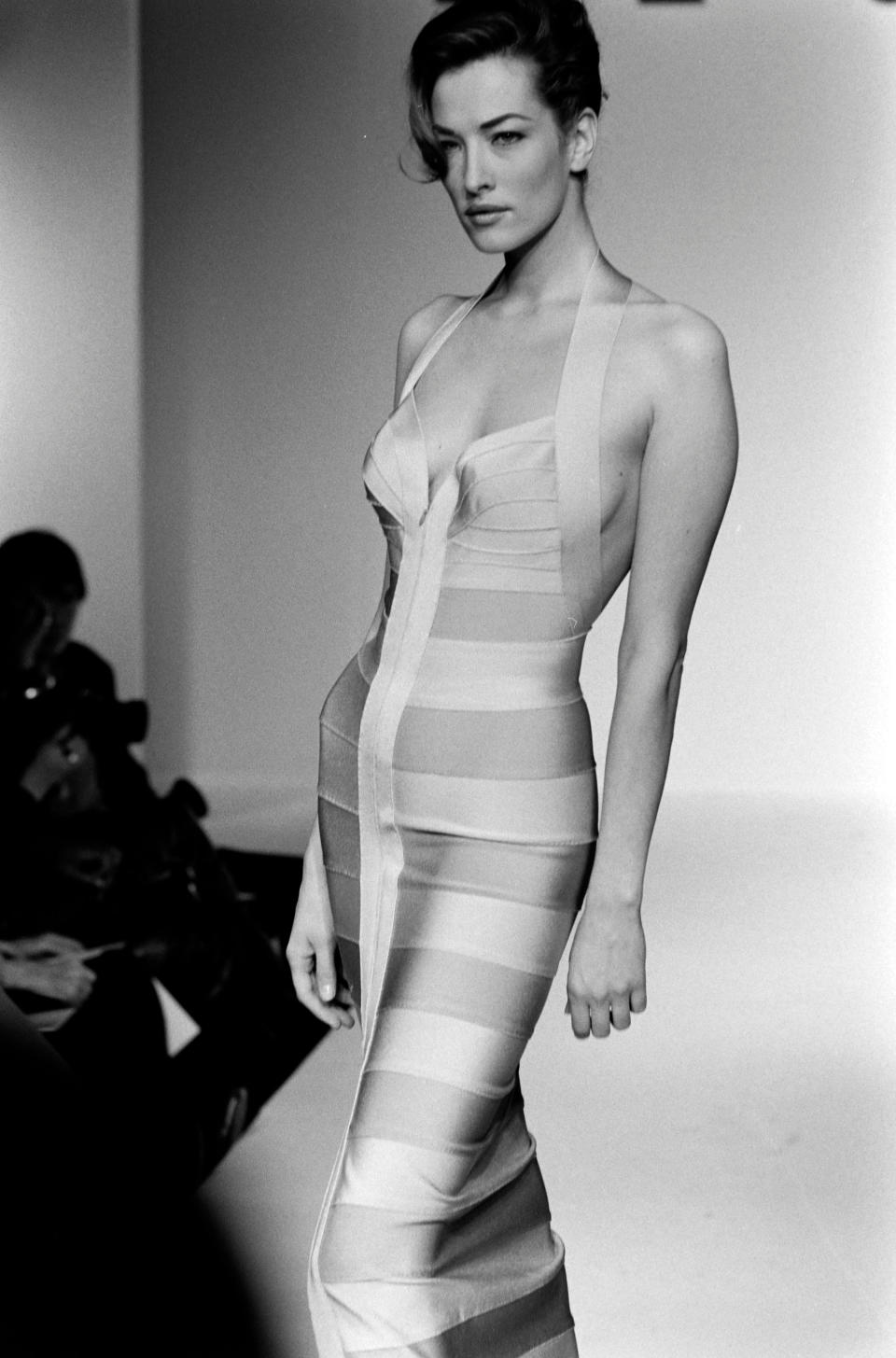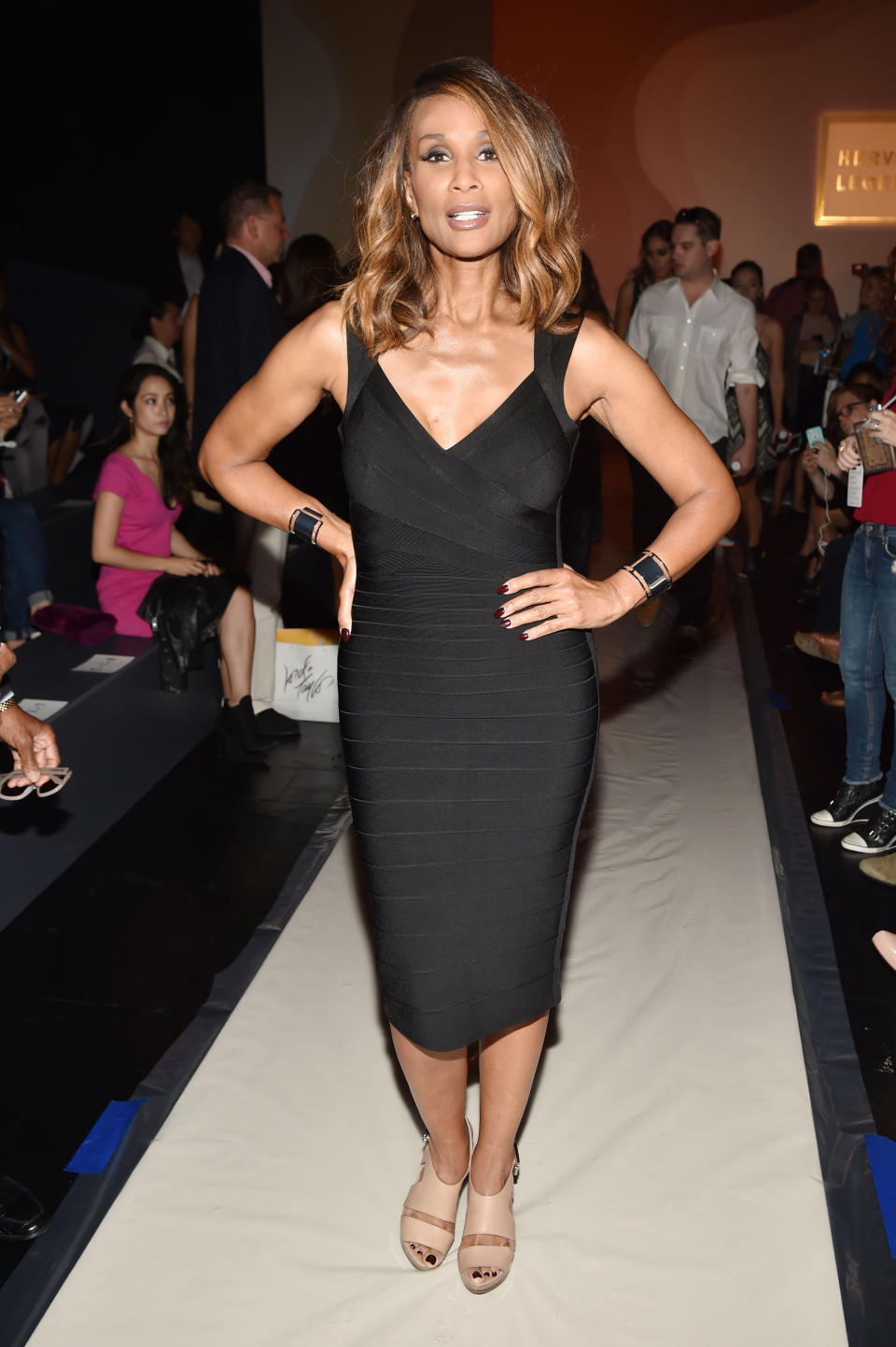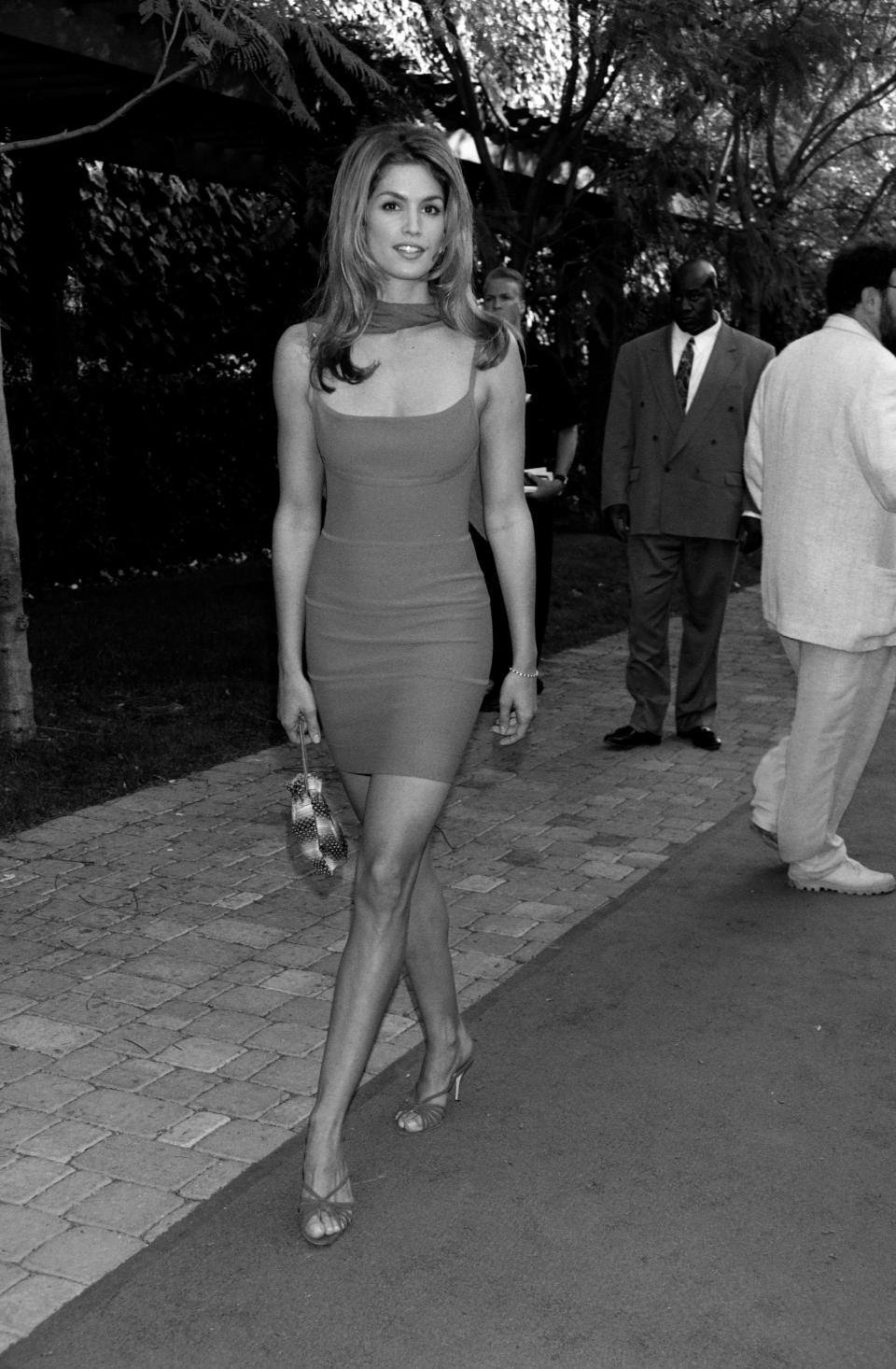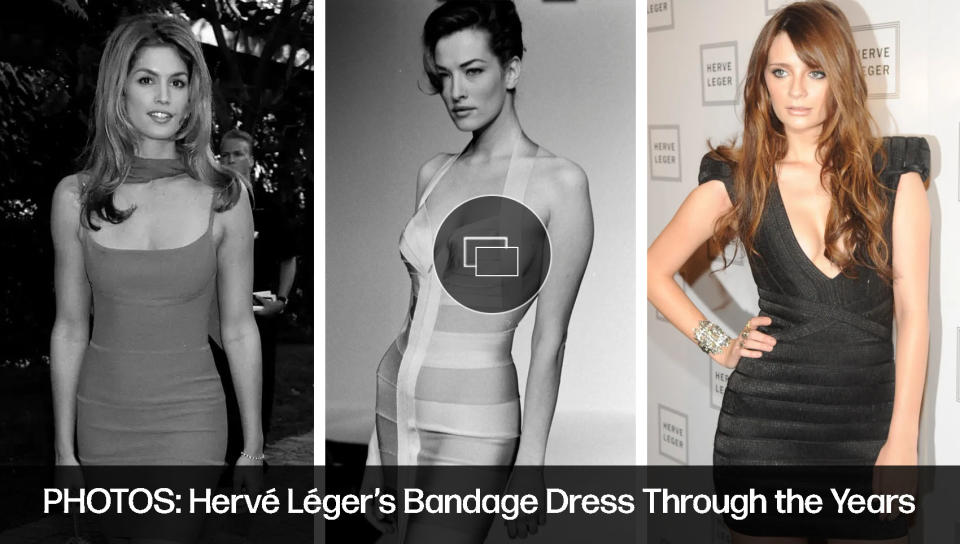The Bandage Dress: The Sexy, Body-con Fashion Statement: A History and Timeline
- Oops!Something went wrong.Please try again later.
- Oops!Something went wrong.Please try again later.
- Oops!Something went wrong.Please try again later.
- Oops!Something went wrong.Please try again later.
- Oops!Something went wrong.Please try again later.

One of the fashion industry’s most iconic dresses is the bandage dress, the form-fitting dress that was the uniform of ’90s models. It was created by designer Hervé L. Leroux, who went on to become Hervé Léger.
Leroux, who was actually born Hervé Peugnet on May 30, 1957, in Bapaume in northern France, studied sculpture and art history at the École Nationale Supérieure des Beaux-Arts in Paris before dropping out to become a hairstylist and milliner.
More from WWD
California Fashion Association President Ilse Metchek Stepping Down
AI Can Revolutionize E-commerce, Says Svetlana Kordumova, Founder and CEO of Pixyle.ai
Ronny Kobo Celebrates New Partnership With Wishi, a Personalized E-commerce Platform
In 1981, he met Karl Lagerfeld who encouraged him to pursue a career in fashion design. Lagerfeld advised him to change his surname to Léger which would be easier for Americans to pronounce. Léger worked alongside Lagerfeld at Fendi and later Chanel, and freelanced at Lanvin and Diane von Furstenberg before launching his own business in 1985 and trademarked the name Hervé Léger. [He assumed the name Hervé Leroux in 2000 after he lost the rights to Hervé Léger.]
The house ventured into ready-to-wear in 1993 and its viscose “bandage” dresses — formed from dozens of elasticated bandage-style strips of knitted cloth, creating a body-sculpting, skin-tight silhouette — became an immediate sensation, with sales soaring from $600,000 generated solely from haute couture in 1992 to $10.6 million in 1984, thanks to its ready-to-wear and the debut of a cruise collection. British Royal Serena Linley became a fan, as did the late Diana, Princess of Wales, who sported one of Léger’s backless dresses at Versailles. Nicole Kidman wore them in “Batman Forever.”

The bandage dress quickly became a go-to choice for celebrities on the red carpet. Those who have been seen in the bandage dress include Kim Kardashian, Blake Lively, Rihanna, Paris Hilton, Britney Spears and Victoria Beckham. The dress, which not only provided support, accentuated the wearer’s curves, giving them an hourglass shape.
At first family-run, the Hervé Léger house received much-needed backing in 1994 from Seagram Co. Ltd.’s Paris-based Champagne G.H. Mumm & Cie division, which also took a 50 percent stake in the company. This enabled its Paris runway shows to grow more lavish and its retail distribution to increase. A Paris boutique on Rue Faubourg Saint-Honoré opened in 1995.
In October 1998, Azria bought roughly 99 percent of the capital of Hervé Léger as well as the trademarked name from Seagram’s for an undisclosed sum. The beverage giant had put some $19.8 million into Léger over the course of four years, and the house had losses of $3.3 million to $4.1 million annually on sales of roughly $10 million wholesale, 40 percent of which was in the U.S.
“I see a lot of synergies between Hervé Léger and BCBG,” said Max Azria at the time, noting that he had been looking for some time to buy a French company that would enable him to grow in Europe and diversify into the designer category.
When Azria bought Léger, it was saddled with huge overhead, including ateliers for couture and a rtw staff of 31 full-time employees. But rather than cut back on overhead, since it is a rare asset to have such skilled in-house ateliers, Azria had hoped to compensate by growing sales fast.

He hired a new president, Bernard Calvet, a fixture in French industrial circles known for his career at Shell Oil Co. The goal, Calvet said at the time, was to expand production from three collections annually — fall and spring rtw plus a cruise collection — to a total of seven. The house had a small private couture business, but Azria wanted to add two couture collections and two pre-collections. He also opened stores in Los Angeles, Paris and New York.
In April 1999, Azria ousted Léger, saying, “I gave a chance to the designer. I bought the company because I believed that it could be profitable, and I had the vision that we could turn it around. We gave Hervé the opportunity to express himself and be the best he could be. We reinforced the infrastructure. But the whole new team in place could not work with [him].
“We know what we are doing,” Azria added. “At the end of the day, the bottom line is the product you put on the table. The Léger collection will be more modern, more sophisticated, and the concept will be recognized as the spirit of the sexy woman. This is what the consumer wants and expects.”
That same month, Azria hired knit specialist Eric Sartori as head designer, but Sartori quit in October 1999, less than a month after showing his first collection. Léger couture designer Jerome Dreyfuss, who showed his only couture collection for the house in July 1999, also departed, in November 1999.
(For his part, designer Hervé Léger launched a collection and a Paris shop in 2000 under the moniker Hervé L. Leroux — another suggestion from Lagerfeld.)
The Léger brand went on hiatus until it returned to retail in 2007 under the design direction of Max and Lubov Azria, and it made its debut at New York Fashion Week in February 2008 as Hervé Léger by Max Azria, showing the fall 2008 collection.

WWD’s fall 2008 review read: “With a new generation of Hollywood starlets pouring their Pilates-toned bods into Hervé Léger’s signature bandage dresses, Max Azria decided to present his first Léger runway show since acquiring the company. Yet instead of resting on Léger’s laurels, Azria worked to make the bandage look his own with some variations in knits and a palette of pretty dégradés. He decorated many with a variety of feathers and silk organza appliqués, but at times got carried away. This is a look that’s best left unadorned, as exemplified in a parade of 15 full-on bandage dresses, all of them cut up to here and plunging to there.”
Said Lubov, “The bandage dress is a true innovation because there’s nothing like it in the market. There are no patterns. The individual bandages are dabbed with pins and sewn together by hand. So basically, it’s a labor of love. As much as you see the product everywhere, it’s not made in large quantities. Sometimes we only make two of a style but the most we make is 100. It’s a very focused business and to work with one type of yarn is so challenging, and yet amazing.”
Since then, Lubov endeavored to innovate the materials and the styles.
“To have that brand and to work on that brand is such an honor, and we respect it, and I think that’s the reason we are able to innovate it constantly,” she said. The designers tried to make some less body-conscious pieces, such as A-line skirts, but other design elements, like raglan sleeves, were left on the drawing board. “We tried so many different silhouettes, but with bandages, unless they are really close to your body, they don’t look that attractive,” said Lubov.
Still, she insisted that a woman need not have a model figure to carry off a Léger.
“Most people say it’s about body shape but I think it’s about confidence level. What’s great about Hervé Léger is when you put that dress on, it changes everything. People look at you differently,” said Lubov.
In 2014, Hervé Léger was sold in 92 wholesale doors and had 13 boutiques in the U.S.: in Southern California on Rodeo Drive; at Westfield Century City mall; on Melrose Avenue, and in South Coast Plaza; in New York’s SoHo and on Madison Avenue; in Las Vegas’ Miracle Mile Shops and The Venetian; in Florida’s Palm Beach and Aventura; Atlanta; Troy, Mich., and Paramus, N.J.
Internationally, its major retail partners included Harrods, Selfridges, Tsum and Harvey Nichols, and there are brand boutiques in Paris; Rome; London; Geneva; Luxembourg; Manila; St. Petersburg, Russia; Moscow (two); Beirut; Abu Dhabi; Dubai (two), and Adelaide, Australia. The greatest growth opportunities were seen in the Middle East, and within the shoe, handbag and fragrance categories.
In February 2017, BCBG filed for bankruptcy protection. In August 2017, Marquee Brands LLC acquired the entire portfolio of brands from BCBG Max Azria Global Holdings, LLC, including BCBGMaxAzria, BCBGeneration, and Hervé Léger. In October 2017, brand management firm Authentic Brands Group acquired the Hervé Léger brand from Marquee Brands. Terms of the transaction weren’t disclosed.
In 2017, Leroux died of a ruptured aneurysm at the age of 60. WWD reported in his obituary that Dita Von Teese, the burlesque star, wrote on her Instagram, “He made the most exquisite dresses that showcased a woman’s beauty, rather than distracting from it. We would have the best time, I honestly could have only ever worn his dresses.”
Alexis Mabille recalled in the WWD obituary that in the ’90s, Leroux’s catwalk shows — featuring the likes of Cindy Crawford, Nadja Auermann, Carla Bruni and Helena Christensen — were among the hottest tickets in town. “If you had a banging body, you wore Hervé Léger or Alaïa,” he said.
“The dresses are impeccable. If you are fortunate enough to see them up close, it’s absolutely amazing. They sculpt the body with a support structure inside, but everything is very comfortable. You could be a fantasy version of yourself, totally gorgeous with a controlled waist and hips, yet still be at ease,” Mabille said.
In 2018, Christian Juul Nielsen became creative director of Hervé Léger. During his tenure, he married the sensual simplicity of iconic ’90s Hervé Léger. with the cutting-edge minimalism of his native Denmark. His draping-focused design approach celebrated the female form.
In 2023, Michelle Ochs, who designed the luxury womenswear collection, Et Ochs, was named as creative director of Hervé Léger, taking over from Nielsen. Nielsen planned to focus on his own label, Aknvas, an advanced contemporary line he launched in 2019.
“As the newly appointed creative director of Hervé Léger, my goal is to propel the brand into the future defined by innovation, sophistication and empowerment. I envision a journey where tradition meets modernity, crafting pieces that resonate with the modern woman while honoring the brand’s iconic legacy,” said Ochs this month, adding that they are committed to elevating the brand’s global presence.
Melissa Lefere-Cobb, senior vice president, division head of Hervé Léger at Centric Brands [which licensed it from Authentic] said, “For almost a decade, we have worked extremely close with Authentic Brands Group to expand Hervé Léger’s presence and preserve its legacy as a world-renowned brand. This success take form through the expansion of the brand’s wholesale accounts, the deepening of its retailer relationships and its high engagement with top-tier talent and celebrities. Since bringing Michelle Ochs on board as creative director, we have experienced an increase in brand popularity and visibility, transcending generations and reaffirming Hervé Léger’s status as an icon in the luxury fashion space.”
The brand is available at retailers such as Neiman Marcus, Saks Fifth Avenue, Revolve, Net-a-porter, Selfridges and Harrods.
Recently, Ochs, in collaboration with stylist Andrew Mukamal, crafted a dress for Margot Robbie’s press tour. The dress drew inspiration from the iconic “No. 1” dress from 1959, a piece that is showcased in the upcoming book, “Barbie: The World Tour.” Other noted celebrities that Ochs has dressed in Hervé Léger include America Ferrera, Shay Mitchell, Rita Ora, Tessa Brooks, Jenna Dewan, Leslie Bibb and Meghan Fox.
Hervé Léger’s Bandage Dress: Through the Years on Runways & Red Carpets [PHOTOS]



In showing her debut fall ’24 last February, Ochs said, “We’re still building on the DNA.” Bandage fabric strips, and their cinching power, were seen throughout, like a red tank dress — a signature color — but also in a range of layering pieces like sheer tops or liquid button-downs with a subtle strip of well-known fabric down the back, WWD reported.
Launch Gallery: Hervé Léger’s Bandage Dress: Through the Years on Runways & Red Carpets [PHOTOS]
Best of WWD


